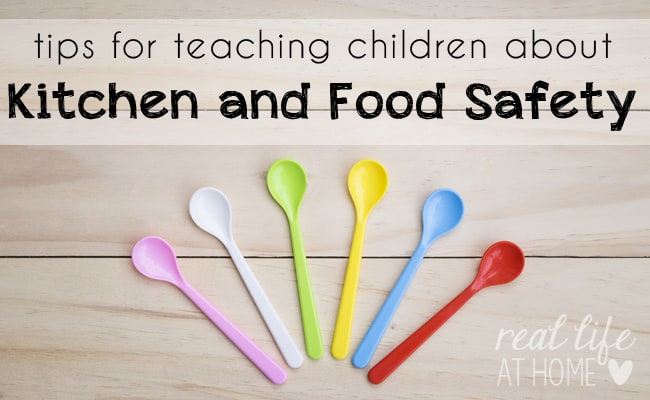Since we’ve talked about teaching kids about making menus and preparing meals, it seems like it’s a great time to talk about teaching children about food and kitchen safety. While you probably (hopefully) know all about kitchen safety, there are things that you probably take for granted about what is safe in the kitchen and what is not.
Kids don’t start off knowing how to be safe in the kitchen. While they’ll know some things from watching you, others are the kinds of things they won’t learn until they do it and then you freak out. So, save yourself some freaking out by working on some kitchen safety skills while teaching children how to survive in the kitchen.

Teaching Children about Kitchen and Food Safety: A Lesson in Tens
Things to Teach Children about Food Safety
1. Always wash hands before (and after) food preparation. Not only do you carry germs on your hands, but there can be harmful items that you are preparing.
2. Wash hands during food preparation, especially after handling items like raw meat and eggs. As a general rule, let them know that it’s a great idea to wash their hands many times during food prep.
3. Don’t use the same knives or cutting boards (during the same session of food preparation) for raw meat and for other items, such as fruits and vegetables.
4. Fruits and vegetables should be washed prior to use. This even includes things that you might not expect, such as watermelon. Otherwise, you could drag your knife along the rind, pick up bacteria on the knife, and then slice that into the fruit. Blech!
5. Hot foods should be kept hot, and cold foods should be kept cold. If a food has been sitting out for more than two hours (that is supposed to be hot or cold), you will need to get rid of it.
Teach kids that this is because microorganisms will grow on the food, and could make you sick.
6. When thawing food, it’s safest to do it either overnight in the refrigerator or in cold water. That cold water needs to stay cold the whole time, so it may mean the need to change the water.
7. When using knives, always cut away from you. Children have a tendency to try to cut in a way that is very comfortable, which sometimes means they want to cut toward themselves. Teach them all about proper knife holding and usage.
8. When you cook something on the stove top that has a lid, teach children to open the lid away from them. To help them remember, you could have them put their hand far above the steam (with your supervision) to see how hot steam can be. Tell them to imagine how hot that would be much closer and right in their face.
9. Work with your children (of reading age) with recipes. Help them to follow directions carefully, as not following them can sometimes pose a risk to their safety or your family’s health.
Of course, as they get older, you can teach them that sometimes, it’s not important to follow directions exactly, as some recipes are perfectly okay to change.
10. Teach them that, while baked good doughs may smell amazing, if they have raw eggs in them, it’s just not safe to eat them. Instead, tell them that you can work on making some eggless cookie dough to eat raw in place of what they actually wanted to sample.
Things to Teach Children about Kitchen Safety
 1. One great starter way for children to help in the kitchen is helping with the dishes. This could be loading and unloading the dishwasher, or even washing or drying dishes. (Young children may really enjoy the “water play” aspect of that.)
1. One great starter way for children to help in the kitchen is helping with the dishes. This could be loading and unloading the dishwasher, or even washing or drying dishes. (Young children may really enjoy the “water play” aspect of that.)
You’ll need to help children to learn to do these safely, taking special care to work on appropriate water temperature. It will also be important to teach your child what you want them to do about sharp utensils.
In our house, they can help with dishes, but when they first started helping, they weren’t allowed to wash or put away things like knives.
2. Never walk away from items that you are cooking on the stove top. Items can easily burn, boil over, or even cause a fire.
3. Don’t leave cooking utensils in a pan or pot while you’re cooking. If they’re plastic, they may melt. If they’re metal, they will become way too hot.
4. Even after you are done using a burner on the stove top, it can stay hot for quite some time. Don’t touch a burner if you aren’t sure about its temperature.
5. Avoid rushing around while you’re cooking or baking. It always seems to be those times when kitchen accidents happen.
6. Be sure to show your child where you keep a fire extinguisher in your kitchen and how to use it. (Hang on — if you say, “Um…I don’t have one.” Then for the sake of your family’s safety, go get a small fire extinguisher for your kitchen.)
7. Close cabinet and pantry doors after you are done using them. Hitting your head on a cabinet hurts!
8. Always use a hot pad or oven mitt to remove items from the oven. For young children, this should be a Mom or Dad job. (Make sure they understand this and don’t try to do some baking while you’re not around.)
9. Speaking of the oven, teach them to make a habit of opening the oven door to make sure it’s empty before preheating it. This is especially important with younger children in the house who have figured out how to open the oven. One plastic army man melted in the oven is one too many.
10. This is not one to teach them per se, but for your child’s kitchen safety, if they are small, provide them with a non-slip stool or even a special stand, like Kitchen Helper. They will be safer if they are at an appropriate level for helping in the kitchen.
Things to Teach Children about Microwave Safety
1. Never use the microwave when it is empty. At the very least, make sure there is a cup of water inside. (This is good for when you are teaching them about using the microwave.)
2. If the microwave has been damaged, don’t use it!
3. Dishes that you use in the microwave must be rated as “microwave safe.” Teach your children how to look for this note – either microwave safe or “not safe for microwave use.” Talk about the general types of materials that are okay and not okay to use in the microwave, as well as showing them some examples with your own dishes.
4. Don’t use anything metal in the microwave. Let children know that this also includes aluminum foil or plates that may look mostly fine but have a metal design on them.
I, personally, have caused lightning-type sparks in a microwave twice. Once was an Arby’s wrapper and once was a Christmas themed mug with a “gold” writing of “Jesus is the Reason for the Season.” Neither time was enjoyable.
5. If you have used a covering of something like paper towel or wax paper on top of the dish you have microwaved, make sure to lift the covering away from you. The steam could possibly burn you.
6. For items that have been microwaved longer, a potholder or oven mitt may help for taking the dish out of the microwave. You might decide to just tell your child to use an oven mitt or potholder every time they take things out.
7. Food in the microwave doesn’t always heat up evenly. Even though one area of food may still be cool, another area can be crazy hot. It’s a great idea to stir the food well before assessing its temperature (and before eating it).
8. It’s a great idea to cover food items that you microwave with things like paper towel, waxed paper, plastic wrap, or a microwave safe lid/cover. This can help keep the microwave clean, as well as to help with the cooking.
9. Keep your microwave clean! Show your children that if food gets splattered in the microwave, it’s a good idea to clean it up right away.
10. Microwaves can be dangerous. Tell children not to use them when they are unsupervised until you feel comfortable that they are ready to use them on their own.

There are tons of safety concerns with food and in the kitchen! Help me think of some that I’ve missed in my list of tens.
Other Posts You’ll Enjoy:
This post was originally published on April 24, 2012. It was last updated on October 26, 2016.
Disclosure: This post contains affiliate links. They do not change the price you pay, and we may receive a small compensation when you shop through the links. Thanks!

The post Tips for Teaching Children about Kitchen Safety and Food Safety appeared first on Real Life at Home.





















